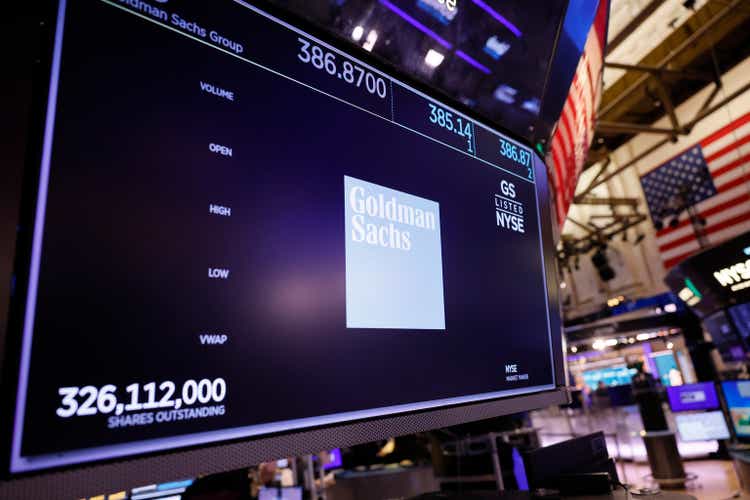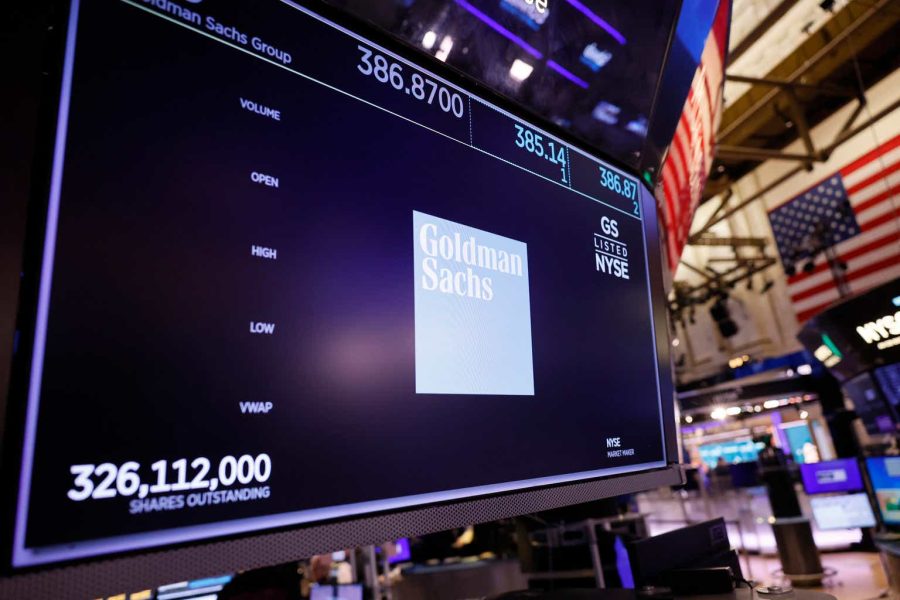Summary:
- Goldman Sachs is refocusing on investment banking and trading, yielding positive results with an impressive earnings beat in Q1 2024.
- The bank’s strong deal flow and revenue growth in the investment banking sector, positions them well for future success and earnings growth.
- Despite potential risks like rising credit defaults, Goldman Sachs’ focus on high-margin, asset-light revenue sources makes them a strong buy with room for share expansion.
- I think the stock is set up well going into Q2 earnings, making it a strong buy.
Michael M. Santiago/Getty Images News
Investment Thesis
Goldman Sachs (NYSE:GS) is returning back to their basic principles, turning their focus towards their deal making business (Investment Banking) and trading. So far, I believe they have been executing this well. This decision comes after a period of diversification into consumer banking, which culminated in the costly and ultimately unsuccessful Marcus initiative. I believe this renewed focus on high-margin activities has already begun to yield positive results, as evidenced by the bank’s impressive earnings beat in Q1 2024, with earnings per share reaching $11.58, significantly above consensus estimates of $8.56.
This return to their basic principles I think will actually work well given the current market conditions. With a rise in private equity deals and an increased need for debt market advisory and restructuring services, Goldman Sachs is well-positioned to capitalize on market trends. Assuming interest rates go down, even if the rest of the economy is doing poorly, I still think there is the opportunity for ample deal flow in restructuring.
So far, Goldman Sachs has demonstrated strong deal flow, which is crucial for sustaining growth. The bank’s Q1 2024 performance saw net revenues of $14.2 billion, a large contributor being the $2 billion in investment banking fees they collected during that quarter, roughly a 33% year-over-year increase. This revenue increase was also driven by a rebound in global M&A activity, with overall deal volumes reaching $755 billion, an increase of 30% year over year. Based on this data, I think results will prove to be even more promising in the coming quarter. The bank’s focus on high-margin, asset-light revenue sources allows for expansion without significantly increasing credit risk, which is important when trying to maintain a healthy balance sheet and reserve capital for potential credit-related events.
Given these factors and results from the previous quarter, as the company shifts towards their core principles and interest rates lower, I believe their second quarter results will be promising. Therefore I think Goldman Sachs shares represent a strong buy (rating upgrade).
Why I Am Doing Follow Up Coverage
In my previous article from April, I rated Goldman Sachs as a buy. My basis for this was that I believed they were showing the signs of a turn around. Further data, which I will expand on in this article, indicates that the company is in fact well on their way to this turnaround. Contributing to my prediction of their success is also the decrease in interest rate expectations.
With this, I am now upgrading my rating to a strong buy. This follow up converge is meant to show how I think the company cannot just handle a potential upcoming downturn, but excel through it.
Earnings Expectations
Based on current street expectations, Goldman Sachs is predicted to deliver strong earnings in upcoming quarters, driven by a resurgence in their core investment banking activities and an overall increase in deal flow. For Q2 (the most recent quarter), consensus estimates predict an earnings per share (EPS) of $8.42, which is an increase of 173.24% year-over-year growth for the investment bank when they report earnings on July 15th. Goldman Sachs appears to be excelling, their EPS growth is showing it. I believe their turnaround is taking hold.
Adding onto this, the expected revenue for Q2 2024 is $12.37 billion, marking a 13.58% year-over-year jump. I believe this projected revenue growth is largely due to the bank’s strong performance in the investment banking sector, particularly in M&A advisory and capital markets. The rebound I discussed previously in global M&A activity saw deal volumes surge 30% year over year to above $755 billion. With this data in mind, it leaves me feeling confident that I was correct in stating the company has begun their turnaround.
Continuing to look ahead past Q2 2024, the bank’s earnings trajectory remains positive. For Q3 2024, consensus estimates project an EPS of $8.49, a 55.17% increase from the previous year, and revenues of $12.53 billion. This continued strong performance is expected to be driven by a strong deal flow and a rise in transactions in the investment banking division.
What I Am Looking For On The Call
As Goldman Sachs continues to execute their pivot back to their core investment banking and sales & trading activities, I’ll be watching for evidence that their back to basics approach on what works, is still accelerating.
Above all, I will be looking for evidence on accelerated deal flow. So far in the first quarter, the bank already showed evidence of increasing deal flow. I think considering interest rates have begun to fall and expectations have done the same, deal flow should accelerate.
So far, I think this expectation is well founded. For example, during the Goldman Sachs’, appearance at the Bernstein Conference, John Waldron, Goldman’s COO stated:
we’re seeing some real signs of improvement in the last few months in terms of mandates and pipeline, and so I’m pretty bullish on M&A – Conference Transcript.
As their M&A market expands, this opens more business opportunities for Goldman Sachs, growing this revenue stream in dealmaking. During this same event, Waldron also stated:
The deals we’ve done more recently have tended to be more public because actually the pricing in the syndicated market has been pretty attractive – Bernstein Conference.
I think this is a very good sign for Goldman Sachs; with high interest rates, the IPO market has been super slow (or frozen by some accounts). With interest rate expectations falling, more companies are likely to go public or run public offerings to shore up their balance sheet and benefit from record stock market prices.
Valuation
Goldman Sachs is accelerating, yet the valuation has not caught up yet. If we look at the bank’s valuation data, specifically to their PEG ratio and growth prospects, these numbers don’t match their opportunity set in my opinion. Despite the company’s forward earnings per share (EPS) long term growth (3-5Y CAGR) standing at an impressive 20.03%, 113.18% higher than the sector median of 9.40%, their PEG ratio is not nearly as impressive, with a forward PEG ratio of 0.65 comparing to the sector median of 1.17, a 44.07% discount (and an A- rating by Seeking Alpha’s award winning quant system). This tells me the market is discounting the quality of future estimates for the bank’s earnings (i.e. they do not think they’ll be able to pull off this level of growth). I disagree.
I believe the bank’s forward PEG ratio should at least reach 1, so the market fairly prices in the forward growth prospects in EPS growth. If we saw their forward PEG ratio reach 1, like I think it should, this would represent 53.85% upside in shares. I think there is an asymmetric opportunity here.
In my last article, I discussed how investors will be paying a small premium through the P/E ratio to access a huge EPS growth. This remains the same here in my view, as the company’s FWD Non-GAAP P/E ratio premium is 21.02% compared to their EPS FWD GAAP growth premium of 218.33%. Therefore, based on this, I think the company has a lot of potential, thus justifying my strong buy thesis.
Risks
I think Goldman Sachs presents a strong investment case, but it’s always essential to consider the risks that could impact their performance.
One of the biggest risks is the rising credit defaults. If we see a spike in default on both consumer and commercial loan payments, this could significantly impact the company’s margins as they will have to assign more to their loan loss reserves. Recent data has shown that on a year over year basis, the total delinquency rates have risen across all types of loans. For example, according to a study done by The Mortgage Banking Association (MBA):
The delinquency rate increased by 18 basis points for conventional loans, increased 112 basis points for FHA loans, and increased 68 basis points for VA loans from the previous year -MBA.
As economic conditions stagnate, in my opinion, the potential for higher credit defaults increases, posing a threat to the bank’s profitability and stability. If interest rates were to go against expectations and actually rise, then this may lead to even higher default rates given many loan products have variable interest-rate clauses.
Given this, management has acknowledged this risk and has implemented measures to mitigate it. Goldman Sachs has started reducing their consumer exposure to loan defaults by offloading a portfolio of what were previously Marcus loans. For example, just last year, the company offloaded over $1 billion of consumer loans to Varde.
Another example of Goldman Sachs’ focusing less on consumer loans comes from The Goldman Sachs Group, Inc. Bernstein Conference. During this conference, Waldron stated:
The balance sheet revenues, which historically were much larger for the firm are normalizing around $2 billion, that’s equity and debt investments that are the residual balance sheet revenues that come from our balance sheet investments, either legacy positions or investments in funds. That’s about $2 billion on a normalized basis of revenues. – Conference Transcript.
His quote emphasizes how a majority of their revenue on their balance sheet is coming from more reliable sources and legacy investments, reducing the potential for consumer loan defaults hurting them, which I think is key.
Bottom Line
With Goldman Sachs’ return to their core principles of investment banking and sales & trading, I think their coming earnings report will be promising for investors. So far this initiative has proven highly effective, driving substantial earnings growth and enhancing their market position.
The bank’s deal flow, particularly in M&A and capital markets, coupled with strong risk management practices, positions them well for future success. Despite the potential concerns of rising credit defaults, I think Goldman Sachs has mitigated some of these through stepping back from consumer loans.
With the bank’s low PEG ratio and high growth prospects, I think there is plenty of room for the bank’s shares to expand. With their focus on high-margin, asset-light revenue sources, Goldman Sachs is well-prepared to navigate what I see as economic uncertainties and continue delivering strong financial performance. Given this, I believe Goldman Sachs is now a strong buy (rating upgrade).
Analyst’s Disclosure: I/we have no stock, option or similar derivative position in any of the companies mentioned, and no plans to initiate any such positions within the next 72 hours. I wrote this article myself, and it expresses my own opinions. I am not receiving compensation for it (other than from Seeking Alpha). I have no business relationship with any company whose stock is mentioned in this article.
Noah Cox (account author) is the managing partner of Noah’s Arc Capital Management. His views in this article are not necessarily reflective of the firms. Nothing contained in this note is intended as investment advice. It is solely for informational purposes. Invest at your own risk.
Seeking Alpha’s Disclosure: Past performance is no guarantee of future results. No recommendation or advice is being given as to whether any investment is suitable for a particular investor. Any views or opinions expressed above may not reflect those of Seeking Alpha as a whole. Seeking Alpha is not a licensed securities dealer, broker or US investment adviser or investment bank. Our analysts are third party authors that include both professional investors and individual investors who may not be licensed or certified by any institute or regulatory body.
